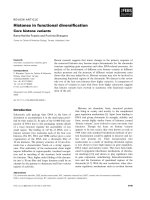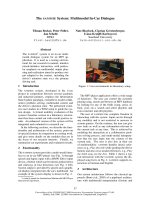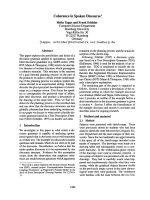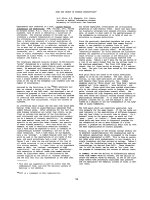Báo cáo khoa học: "ELABORATION IN OBJECT DESCRIFFIONS THROUGH EXAMPLES" pdf
Bạn đang xem bản rút gọn của tài liệu. Xem và tải ngay bản đầy đủ của tài liệu tại đây (276.31 KB, 3 trang )
ELABORATION IN OBJECT DESCRIFFIONS THROUGH EXAMPLES
Vibhu O. Mittal
Department of Computer Science
University of Southern California
Los Angeles, CA 90089
USC/Information Sciences Institute
4676 Admiralty Way
Marina del Rey, CA 90292
Abstract
Examples are often used along with textual descrip-
tions
to
help convey particular ideas - especially in
instructional or explanatory contexts. These accompa-
nying examples reflect information in the surrounding
text, and in turn, also influence the text. Sometimes,
examples replace possible (textual) elaborations in the
description. It is thus clear that if object descriptions
are to be generated, the system must incorporate strate-
gies to handle examples. In this work, we shall inves-
tigate some of these issues in the generation of object
descriptions.
INTRODUCTION
There is little doubt that people find examples very ben-
eficial in descriptions of new or complex objects, rela-
tions,orprocesses. Various studies have shown that the
inclusion of examples in instructional material signifi-
cantly increases user comprehension (for e.g., (Houtz,
Moore & Davis, 1973; MacLachlan, 1986; Pirolfi,
1991; Reder, Charney & Morgan, 1986; Tennyson
& Park, 1980)). Users like examples because exam-
pies tend to put abstract, theoretical information into
concrete terms they can understand. Few generation
systems have attempted to make significant use of ex-
amples, however. In particular, most systems have
not integrated examples in the textual descriptions, but
have used them mostly on their own, independently of
the explanation that may also have been provided at
that point. However, examples cannot be generated in
isolation, but must form an integral part of the descrip-
tion, supporting the text they help to illustrate.
Most previous work (especially in the context of
tutoring systems) focused on the issue
offinding
useful
examples (for e.g., Rissland's CEG system (1981) and
Ashley's HYPO system (Ashley, 1991; Rissland &
Ashley, 1986; Rissland, 1983)). Work by Woolf and
her colleagues considered issues in the generation of tu-
torial discourse, including the use of examples (Woolf
& McDonald, 1984; Woolf & Murray, 1987), but their
315
analysis did not address specific issues of integrated
example and language generation.
In this paper, we build upon some of these stud-
ies and describe the issues in generating descriptions
which include examples in a coordinated, coherent
fashion, such that they complement and support each
other.
AN EXAMPLE
Consider for inst,'mce, the example in Figure 1, from
a well known introductory book on the programming
language LISP. It describes an object (a data structure)
called a "fist." There are a number of issues that can
be immediately seen to be relevant:
I. Should the system choose to elaborate on the object
attributes in text, or through the use of examples?
For instance, the information in Figure I could also
have been expressed textually as:
"A list always be-
gins with a left parenthesis. Then come zero or more
pieces of data (called the elements of a list), and a
right parenthesis. Data elements can be of any LISP
type, including numbers, symbols and strings".
In
the figure, the examples arc used to elaborate on two
aslaeCtS of the data-elements: the variable
number
of the elements, and the different
types
of which
these elements may belong to. In some contexts, the
examples tend to re-iterate certain aspects (in this
case, the number was mentioned in the explanation
as well), while in others, the examples tend to elab-
orate on aspects that are not mentioned explicitly in
the description (in our case, the
type
information).
2. Should the system use one example, or multiple ex-
amples? Consider for instance, the following exam-
ple of a LISP list:
(FORMAT T "~2% ~ A ~ A - A" 12345678
' James ' Smith (address person) )
It is not entirely obvious that single examples of the
type above arc always the most appropriate ones,
A list always begins with a left parenthesis. Then come
zero or more pieces of data (called the elements of a
list) and a right parenthesis. Some examples of lists
are:
(AARDVARK) ;;; an atom
(RED YELLOW GREEN BLUE);;; many atoms
(2 3 5 11 19) ;;; numbers
(3 FRENCH FRIES) ;;; atoms & numbers
A
list may contain other lists as elements. Given the
three
lists:
(BLUE SKY) (GREEN GRASS) (BROWN EARTH)
we
can make a list by combining them all with a
parentheses.
((BLUE SKY) (GREEN GRASS) (BROWN EARTH))
Figure 1: A description of the object LIST using ex-
amples (From (Touretzky, 1984), p.35)
even though such examples are frequently seen in
technical reference material. The system must there-
fore be able to make reasonable decisions regarding
the granularity of information to be included in each
example and structure its presentation accordingly.
3. If there are multiple examples that are to be pre-
sented, their order of presentation is important too.
Studies has shown that users tend to take into ac-
count the sequence of the examples as a source of
implicit information about the examples (Carnine,
1980; Litchfield, IMiscoll & Dempsey, 1990; Ten-
nyson, Steve & Boutwell, 1975). For instance, in
Figure 1, the first and second examples taken to-
gether illustrate the point that the number of data
elements is not important.
4. When are 'prompts' necessary? Examples often
have attention focusing devices such as arrows,
marks, or as in the Figure 1, extra text, associated
with them. These help the user disambiguate the
salient from the irrelevant. What information should
be included in the prompts, and in the case of text,
how should be be phrased?
5. How should the example be positioned with respect
to the text? Studies of instructional texts reveal that
examples can occur before the text (and the text
elaborates upon the example), within the text, or (as
in our figure), after the text (Feldman, 1972).
There are other issues that need to be considered
in an integrated framework - some of these that affect
most of the issues raised above are the audience-type,
the knowledge-type (whether the concept being de-
scribed is a noun or a relation for instance) and the
text-type (tutorial vs. reference vs. report, ete). The
316
DESCRI~I~LIST
I
DATA
l.mT $1t'NTA.CT]C ~
I natm.~z
.I .I .I
111'~1111~. I~II~IIIM _. INI~QM._
Figure 2: Plan skeleton for listing the main features of
a LIST.
4.
NU1BIR TYPB
M M
M M-
,~M m/z
Pit~M
ID.CX~OUI~ LIST
OF
Lm~
I I
M lqtolKr [ - ATOMS - NU~K~ /aDM$+ ~/~-/d$'~
FiN 3: Partial text plan for generating the LIST
examples.
issue
of how the examples are selected (generated vs.
retrieved is also an important issue, but we shall not
discuss that here.
STATUS OF WORK
We are investigating these issues by implementing a
system that can generate examples within explanatory
contexts (within theEES framework (Neches, Swartout
& Moore, 1985; Swartout & Smoliar, 1987)) using the
Moore-Paris planner (1992, 1991 ) for discourse gener-
ation. Our initial system is for the automatic generation
of documentation for small sub-sets of programming
languages. One reason for this choice is that it al-
lows us to study a variety of example-rich texts in a
relatively unambiguous domain.
A
partial text-plan
generated by our planner for the description given in
Figure 1 is given in Figures 2 and 3. It shows some of
the communicative goals that the planner needs to be
able to satisfy in order to generate some of the simple
object descriptions in our application. These descrip-
tions can make use of examples (instead of tex0 to
list and describe feature elaborations, or use them in
conjunction with a textual description to clarify and
illustrate various points.
Among issues that we plan to study are the differ-
ences between opportunistic generation of examples
and top-down planning of text with examples, and the
effects arising from differences in the knowledge type,
the text-type and other sources of information.
Acknowledgments
Thanks to C6cile Paris for critical discussions, different
perspectives and bright ideas. This work was supported
in part by the NASA-Ames grant NCC 2-520 and under
DARPA contract DABT63-91 42-0025.
References
Ashley, K. D. (1991). Reasoning with cases
and
hy-
potheticals in HYPO. International Journal of
Man-Machine Studies, 34(6), 753-796.
Carnine, D. W. (1980). Two Letter Discrimination Se-
quences: High-Confusion-Alternatives first ver-
sus Low-Confusion-Alternatives first. Journal of
Reading Behaviour, XII(1), 41-47.
Feldman, K. V. (1972). The effects of the number
of positive and negative instances, concept def-
initions, and emphasis of relevant attributes on
the attainment of mathematical concepts. In Pro-
ceedings of the Annual Meeting of the American
Educational Research Association, Chicago, Illi-
nois.
Houtz, J. C., Moore, J. W., & Davis, J. K. (1973). Ef-
fects of Different Types of Positive and Negative
Examples in I.eaming "non-dimensioned" Con-
cepts. Journal of Educational Psychology, 64(2),
206-211.
Litchfield, B. C., Driscoll, M. P., & Dempsey, J. V.
(1990). Presentation Sequence and Example Dif-
ficulty: Their Effect on Concept and Rule l eam-
ing in Computer-Based Instruction. Journal of
Computer-Based Instruction, 17(1), 35-40.
MacLachlan, J. (1986). Psychologically Based Tech-
niques for Improving Learning within Comput-
erized Tutorials. Journal of Computer-Based In-
struction, 13(3), 65-70.
Moore, J. D. & Paris, C. L. (1991). Discourse Struc-
ture for Explanatory Dialogues. Presented at the
Fall AAAI Symposium on Discourse Structure in
Natural Language Understanding and Generation.
Moore, J. D. & Paris, C. L. (1992). User models and
dialogue: An integrated approach
to
producing
effective explanations. To appear in the 'User
Model and User Adapted Interaction Journal'.
Neches, R., Swartout, W. R., & Moore, J. D. (1985).
Enhanced Maintenance and Explanation of Ex-
pert Systems Through Explicit Models of Their
Development. IEEE Transactions on Software
Engineering, SE-11( l l ), 1337-1351.
Pirolli, P. ( 1991). Effects of Examples and Their Expla-
nations in a Lesson on Recursion: A Production
System Analysis. Cognition andlnstruction, 8(3),
207-259.
Reder, L. M., Chamey, D. H., & Morgan, K. I. (1986).
The Role of Elaborations in learning a skill from
an Inslructional Text. Memory and Cognition,
14(1), 64-78.
Rissland, E. L. (1981). Constrained Example Genera-
tion. COINS Technical Report 81-24, Department
of Computer and Information Science, University
of Massachusetts, Amherst, MA.
Rissland, E. L. (1983). Examples in Legal Reason-
ing: Legal Hypotheticals. In Proceedings of the
International Joint Conference on Artificial Intel-
ligence, (pp. 90 93), Karlsrnhe, Germany.
Rissland, E. L. & Ashley, K. D. (1986). Hypothet-
icals as Heuristic Device. In Proceedings of
the National Conference on Artificial Intelligence
(AAAI-86),
(pp.
289-297).
Swartout, W. & Smoliar, S. W. (1987). Explaining the
link between causal reasoning and expert behav-
ior. In Proceedings of the Symposium on Com-
puter Applications in Medical Care, Washington,
D.C.
Tennyson, R. D. & Park, 0.42. (1980). The Teaching
of Concepts: A Review of Instructional Design
Research Literature. Review of Educational Re-
search, 50(1), 55-70.
Tennyson, R. D., Steve, M., & Boutwell, R. (1975).
Instance Sequence and Analysis of Instance At-
tribute Representation in Concept Acquisition.
Journal of Educational Psychology, 67, 821-827.
Touretzky, D. S. (1984). LISP: A Gentle Introduction
to Symbolic Computation. New York: Harper &
Row Publishers.
Woolf, B. & McDonald, D. D. (1984). Context-
Dependent Transitions in Tutoring Discourse. In
Proceedings of the Third National Conference on
Artificial Intelligence (AAAI.84 ), (pp. 355-361).
Woolf, B. & Murray, T. (1987). A Framework for
Representing Tutorial Discourse. In Proceedings
of the Tenth International Joint Conference on
Artijicial Intelligence, (pp. 189-192).
317









